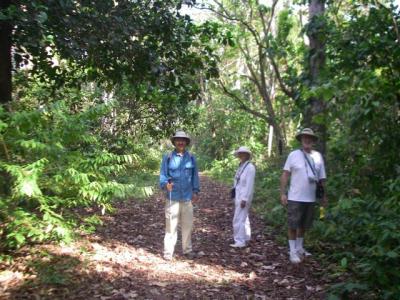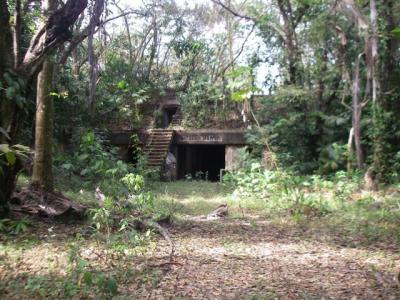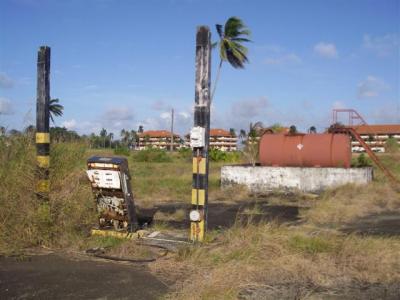Today we waited around for the boat measurer. Christi continued cleaning. Eric spent most of the day socializing, and Christi would join in now and again during cleaning breaks. At 1400, Victor told us if the measurer hadn’t come by now, he wasn’t coming today. Good, at least we could do something fun this afternoon.
At 1530, we went for a walk in the jungle surrounding the marina with Tom and Susan on the Nordhavn 40 from San Diego. Tom and Susan explained that the marina is situated in what used to be an American Navy base, Fort Sherman. The base was constructed in 1911 to protect the unfinished canal. It was abandoned in December 1999 along with all the other American military bases in Panama. The majority of the land that the base encompassed is undeveloped jungle, and it is was one of the primary military training centers for jungle combat training, particularly during the Vietnam era. When the Panamanians took over the land, they turned it into a nature preserve. Tom and Susan walk through the preserve often, and have sometimes seen Panamanian troops doing training exercises in the preserve.
We followed a walking trail behind the marina into the jungle. The trail runs up a gently sloping hill. The path is obviously frequently used, but it doesn’t look like anyone formally maintains it. On both sides of the path the plants tall, thick and dense.

As we were walking along, we were mesmerized by the giant leaf cutter ants. There are zillions of them marching in perfect lines around the trail, most carrying big pieces of leaves much larger than they are. These ants are actually farmers. They cultivate a special fungus in their underground nests. The fungus is fed by the leaf pieces the soldier ants bring back. Interestingly, if the leaf is dropped on the ground, the ants will not take it back to their nest. They abandon the dirty leaf piece and get a fresh new piece to bring back.
We also saw a couple enormous spiders sitting in large webs between branches in trees. Suddenly, a coati ran out onto the path in front of us. Coatis are members of the raccoon family. They have narrow faces with a long, almost pig-like flexible snout nose. They are about the size of a large housecat, with a long tail. They have feet like a raccoon. They are also known as hog nosed raccoons and snookum bears. Neither of us have ever seen one before, so we were excited. We spotted another coati in the brush nearby.
After a few minutes of walking, we came to a long abandoned bunker. Apparently, in the 30’s, the US military built several of these bunkers up on this hill to defend the canal from attack ships. The military realized not too long thereafter that if an attack came, it would be via air, so they stopped using these bunkers. The poor bunkers have been eroding ever since. This bunker is seriously creepy looking. The structure is so covered over with vines and plants that the majority of the concrete is hidden from view. It looks like something out of those sci-fi movies where almost everyone on Earth turns into a zombie, and the handful of survivors have to hide from the zombies. And, invariably, they to try hide in creepy places like this, and invariably, a zombie is crouching in the darkness waiting to attack them.

We explored inside the bunker a little bit, but we didn’t go very far inside. Most of the bunker gets no natural sunlight, so it quickly becomes pitch black beyond the entrance, and we didn’t want to disturb the zombies lying in wait in the dark corridors. It is a large concrete frame with nothing at all inside, almost parking garage-esque. The concrete ceiling is beginning to buckle and fall down in small chunks here and there. We climbed up the exterior stairs to the roof. What shocked us is that the roof is completely covered by large trees. How on earth do the trees grow at all, let along get so big, when they have nothing to sink their roots into? Mother Nature is absolutely amazing in the way she can reclaim her land despite what man does to it. The bunker is situated on the edge of a cliff, and had the trees not been on the roof, there would have been a clear view out to the ocean and bay. We see why this was an attractive spot for the military.
We continued on up the path. We passed a concrete lined hole in the ground, obviously an entrance to an underground bunker. We suddenly felt like we were in the TV show “Lost”, wandering through what looked like pristine jungle and finding a secret and mysterious hatch. We were tempted to go down there to look for the “others”, but fearing capture, we resisted the temptation and continued on the path.

The trail ended at another bunker, which probably is similar in construction to the first one. However, this one is covered with much more jungle growth. We didn’t explore it. Instead, we took the path back to the marina, then followed one of the road that leads away from the marina. We had no clue where the road went to, but knew it wasn’t the main road to town. The road is well maintained, and only two cars passed us the entire time we were walking.
Initially, we walked by some of the remains of the military base’s infrastructure. It has been almost 10 years since most of this stuff has been used. It is clear that no one is actually caring for the infrastructure in and of itself, but someone is doing a good job of keeping the area cleared of jungle growth. The grounds around the former base are covered in very recently mowed short grass. Some infrastructure had deteriorated away to nothing. The gas (petrol) station and solar electricity plant were about as dead as dead can get, and some of the buildings were badly deteriorated. Some buildings looked like they were only now starting to fall apart. And some looked to still be in pretty good shape. We found out that the row of buildings with the red roofs along the shore are not a hotel or condos like we had presumed, but were part of the base. One building is currently being used by the Panamanian coast guard, but the rest are abandoned. All the red roof buildings look like they are in great shape, and we wonder why no one has developed them into something else yet. Why would they choose to develop only one building into a marina office and one into a coats guard office, but do nothing at all with the rest of the grounds? Odd. Here is the gas (petrol) station:

The area with the infrastructure is actually fairly small, and within a few minutes we found ourselves in the middle of undeveloped jungle again. While walking, we saw several White Faced Capuchin monkeys. They are super cute. They are a dark brown all over except for their face, which, as the name implies, is light in color, though probably more of a light tan than white. Most everyone has seen a Capuchin in a movie playing an organ grinder. They are very active. One was sitting in a tree eating berries, but all the other ones we saw were scrambling from limb to limb and from tree to tree. One even jumped from a tree on one side of the road to a tree on the other. He was pretty high up, and had he missed the branch, it would have been a painful fall.
Being on the paved road with the jungle all around us is the best of both worlds. It is easy to walk on. You don’t have to fight off the brush as you walk. And, since you don’t make much noise, you don’t scare off the animals. We were hoping to see an anteater, but no such luck. We trekked along for as long as poor Eric could take it before his toe was hurting too much, then turned back.
Back at the marina, we had a low key evening.
